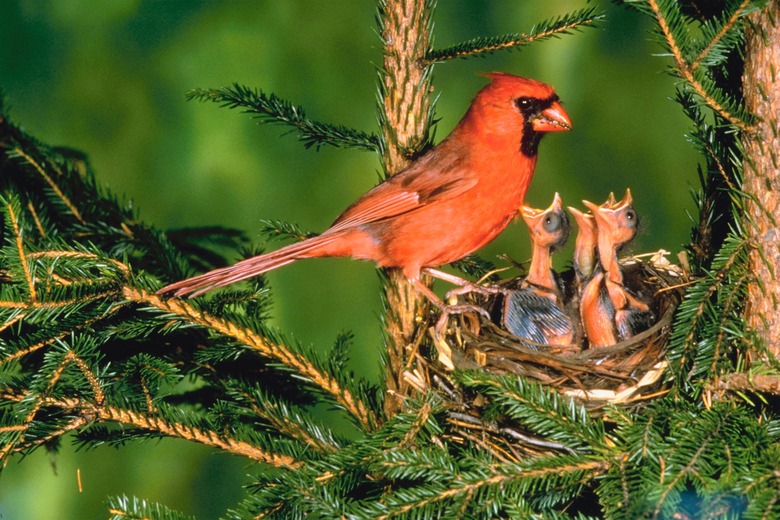Tomato Plants & Cardinals
Cardinals (Cardinalis cardinalis) and tomatoes (Solanum lycopersicum) have little in common other than the color of the ripe fruit and the bird's plumage, yet home gardeners sometimes see them together. The bright red bird birds commonly visit feeders year round.
Cardinals (Cardinalis cardinalis) and tomatoes (Solanum lycopersicum) have little in common other than the color of the ripe fruit and the bird's plumage, yet home gardeners sometimes see them together. The bright red bird birds commonly visit feeders year round. They nest all summer and have to feed not only themselves but also their hungry offspring. Sometimes dinner includes ripe tomatoes.
Cardinals
An attractive bird that often frequents feeders, the bright red male cardinal and his duller brown female partner don't migrate. You can often see them decorating snow covered trees in the middle of winter. These medium-sized birds average 8 to 9 inches in length. A monogamous bird, the cardinal mates for life. The female lays three eggs on average per brood, and she usually has two broods a year but sometimes a third if the weather is mild. Although both birds hunt and feed the young, the male does the majority of the hunting while the female builds the nests and incubates the eggs, which hatch in two weeks. The baby birds fledge around 10 days although the parents often feed them for a few more days.
- Cardinals (Cardinalis cardinalis) and tomatoes (Solanum lycopersicum) have little in common other than the color of the ripe fruit and the bird's plumage, yet home gardeners sometimes see them together.
- The female lays three eggs on average per brood, and she usually has two broods a year but sometimes a third if the weather is mild.
Tomatoes
Commercial tomato breeders select plants for properties that allow farmers to efficiently harvest, store and ship them. In developing easily shipped tomatoes, however, breeders lost some of the original flavor and texture of tomatoes that made them so popular. Home gardeners can grow tomato varieties that produce sweeter, riper, fuller-flavored fruits because they don't have to undergo the rigors of transportation. Every part of the tomato, other than the fruits, is poisonous to people. Tomatoes come in two types: determinant, where the fruit ripens all at once, and indeterminate, which produce fruit throughout the season.
Cardinal Attractor
Tomatoes, especially ripe ones, attract cardinals for several reasons. Cardinals have beaks that are specialized for eating seeds, but they also eat a lot of fruit and a small number of insects. A ripe tomato not only has soft seeds but also a lot of sweet water. On hot days, a cardinal will often look for ripe fruit to slake its thirst. Tomatoes attract several types of insects, including cutworms, fruitworms and big juicy hornworms. Sometimes when a cardinal is snooping around your tomato plants, it is helping prevent damage from pests.
- Commercial tomato breeders select plants for properties that allow farmers to efficiently harvest, store and ship them.
- Cardinals have beaks that are specialized for eating seeds, but they also eat a lot of fruit and a small number of insects.
Protecting Tomatoes
People frequently fill their feeders with sunflower or safflower seeds for adult cardinals. One way to protect tomatoes is to add over-ripe fruits, especially berries, to feeders. Adding a source of water — preferably dripping water — not far from the garden can distract thirsty birds. Lightweight bird netting, draped over the tomato plants or supported from stakes, will protect ripening tomatoes. Putting bags over the tomatoes themselves allows the fruit to ripen while staying protected.
